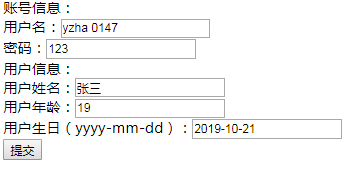新建了一个class,添加注解设定一级路径为 annotation
@RequestMapping(path = "/annotation")
里面添加了方法用来测试:
1.
RequestParam (加在controller方法的参数前)
用来规定参数名字
@RequestMapping(path = "/RequestParam") public String requestParamTest(String name, String password){ System.out.println("name = " + name); System.out.println("password = " + password); return "success"; }
不插入注解时,前台需要传递两个参数,name 和 password
@RequestMapping(path = "/RequestParam") public String requestParamTest(String name, @RequestParam(name = "p") String password){ //插入注解后,前台需要传递的参数变为name 和 p System.out.println("name = " + name); System.out.println("password = " + password); return "success"; }
插入注解后,前台需要传递的参数变为name 和 p
插入注解后的jsp部分:
<a href="annotation/RequestParam?name='yzha'&p='123456'">RequestParam test</a>
2.
RequestBody
拿到post请求的请求体(key=value的格式,处理json格式数据时会用到)
get请求:一般是超链
post请求:提交表单
RequestHeader: 获得请求头,用得比较少
CookieValue:将cookie值传回,可以用来生成浏览记录
java的controller方法:
@RequestMapping(path = "/RequestBody") public String requestBodyTest(@RequestBody String body, @RequestHeader(value = "ACCEPT") String accept, @CookieValue(value = "JSESSIONID", required = false) String cookie){ //RequestBody:将所有参数变成一个字符串传回接收 //RequestHeader:将请求头传回,用字符串接收。 //CookieValue:将cookie传回,用字符串接收。 System.out.println(body); System.out.println("---------------------"); System.out.println(accept); System.out.println("---------------------"); System.out.println(cookie); return "success"; }
jsp:
<form action="/annotation/RequestBody" method = post> 账号信息:<br/> 用户名:<input type="text" name = 'name'><br/> 密码:<input type="text" name = 'password'><br/> 用户信息:<br/> 用户姓名:<input type="text" name = 'user.name'><br/> 用户年龄:<input type="text" name = 'user.age'><br/> 用户生日(yyyy-mm-dd):<input type="text" name = 'user.birthday'><br/> <input type ="submit" value = "提交"> </form>
输入:

输出:

RequestBody的整体格式类似get的传参方法,空格变成了+,汉字变成了编码
3.
PathVariable
用来添加url的占位符,一般用来实现restful的编程风格
关于restful:
https://www.cnblogs.com/clamp7724/p/11714650.html
java的controller方法
@RequestMapping(path = "/PathVariable", method = RequestMethod.GET) public String pathVariableTest1(String name){ System.out.println("根据name = " + name + "查询"); return "success"; } @RequestMapping(path = "/PathVariable/{userid}", method = RequestMethod.GET) //{}中的参数名字需要与下面@PathVariable中name一致 public String pathVariableTest2(@PathVariable(name = "userid") String id){ //用了PathVariable后,需要在路径格式为 /PathVariable/100 这种 System.out.println("根据id = " + id + "查询"); return "success"; }
jsp部分
<div> <a href="annotation/PathVariable?name='yzha'">RequestParam test1</a><br/> <a href="annotation/PathVariable/20?name='yzha'">RequestParam test2</a> </div>
后台输出:

4. ModelAttribute
修饰方法时,方法会在当前class中的controller运行前提前运行,可以接收前台传过来的参数,没有对应参数的时候为默认值(null或者0)。
因为Spring是利用反射调用对象的set方法对对象进行赋值,所以预处理的对象被之后的controller接收到后,会利用set方法进行赋值,预处理的值可以保留(返回值和controller参数的名字和类型一致),不会影响controller的正常运行。(我知道可能看不懂。。。总是这里很抽象- -)
修饰参数时,把这个注解的value的值作为key,获取map对应的value。 (map需要在@ModelAttribute修饰的方法中预先定义)
public @interface ModelAttribute { @AliasFor("name") String value() default ""; @AliasFor("value") String name() default ""; boolean binding() default true; }
这是源码。。。别被绕进去了- -虽然是ModelAttribute的value属性,但是值是作为map的key。。。
他的key才是value
场景
比如一个网站用户注册网站旗下游戏账号时,自己的信息可以直接从网站获得,不需要填写。所以可以用modelAttribute预处理数据
利用返回值预处理:
java部分:
//ModelAttribute @RequestMapping(path = "/ModelAttribute") public String modelAttributeTest(Account account){ System.out.println(account); return "success"; } //预处理部分 @ModelAttribute public Account dealWithNullAttribute(String name){ System.out.println("新增用户:" + name); //模拟查询数据库后获得了user信息 User user = new User(); user.setName("张三"); user.setAge(20); SimpleDateFormat simpleDateFormat = new SimpleDateFormat("yyyy-MM-dd"); Date d = new Date(); try { d = simpleDateFormat.parse("1990-05-26"); } catch (ParseException e) { e.printStackTrace(); } user.setBirthday(d); Account account = new Account(); account.setUser(user); return account; }
jsp部分:
<div> <form action="/annotation/ModelAttribute" method = post> 账号信息:<br/> 用户名:<input type="text" name = 'name'><br/> 密码:<input type="text" name = 'password'><br/> <input type ="submit" value = "提交"> </form> </div>
输入:

输出:

利用map (我把上面那个ModelAttribute的java部分注释掉了)
java:
//ModelAttribute @RequestMapping(path = "/ModelAttribute") public String modelAttributeTest( @ModelAttribute("aaa") Account account){ //把map中value = aaa的 key作为预处理对象 System.out.println(account); return "success"; } //比如一个网站用户注册网站旗下游戏账号时,自己的信息可以直接从网站获得,不需要填写。所以可以用modelAttribute预处理数据 //预处理部分 (不需要返回值) @ModelAttribute public void dealWithNullAttribute(String name, Map<String, Account> map){ //一个字符串 和 Account对象作为键值对的Map System.out.println("新增用户:" + name); //模拟查询数据库后获得了user信息 User user = new User(); user.setName("李四"); user.setAge(20); SimpleDateFormat simpleDateFormat = new SimpleDateFormat("yyyy-MM-dd"); Date d = new Date(); try { d = simpleDateFormat.parse("1990-05-26"); } catch (ParseException e) { e.printStackTrace(); } user.setBirthday(d); Account account = new Account(); account.setUser(user); map.put("aaa", account); }
jsp:
<div> <form action="/annotation/ModelAttribute" method = post> 账号信息:<br/> 用户名:<input type="text" name = 'name'><br/> 密码:<input type="text" name = 'password'><br/> <input type ="submit" value = "提交"> </form> </div>
输入:

输出:

另外,如果controller写成
public String modelAttributeTest( @ModelAttribute("aaa") Account account, Map<String, Account> map)
可以直接用
Map<String, Account> map
接收整个预处理创建的map